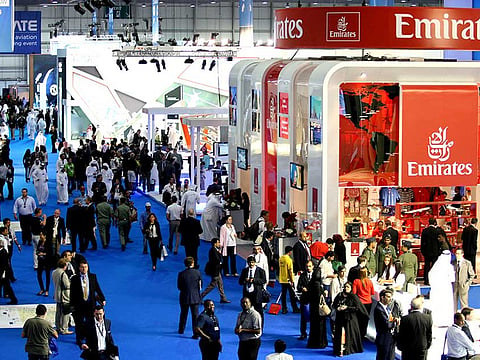Dubai Airshow the go-to event for aviation industry
Dubai is a growing air show because more than just the big airframe, manufacturers want to be there — everyone needs to be there

Trade shows are an opportunity for entire industries to come together; to trade, to catch up, to exchange views and of course, to gossip.
For a long time, the world’s commercial aviation industry meets annually at one of two European trade shows, rotating between Paris’ Le Bourget and London’s Farnborough. Now, there is a new kid on the block.
The Dubai Air Show is rapidly becoming the go-to event for the airline industry. It is obvious why the big airframe manufacturers want to go to Dubai — that is where the customers are. For the rest of the industry the growth and continued popularity of Dubai’s air show underscores a more fundamental truth. The reason the Gulf’s airlines are customers worth travelling to talk with is because the centre of gravity in the world’s aviation industry is changing. It is moving eastward.
Dubai is a growing air show because more than just the big airframe manufacturers want to be there — everyone needs to be there to trade. Seats, interiors, galley systems, catering equipment — all the parts that make up an aircraft and the aviation industry will cluster around the airframe to trade too.
There are implications in that market shift beyond decisions about where to stage air shows. It reflects the new and growing markets of Africa, Asia and the Middle East and most importantly, how the Gulf’s airlines are reacting to that shift.
However, as Newton taught us, for every action there is an equal and opposite reaction. The Gulf carriers’ market actions have stirred up reaction in Europe and in the United States. Sadly, at their worst, the legacy carriers of Europe the United States have called for increased protectionism, invoking talk of a trade war. It has not been an edifying sight.
A trade war, it goes without saying, is not something anyone would wish on the world. It will most certainly not help the airline industry, or the industry’s passengers. To be fair, some in Europe and in the US understand that. The European Transport Commissioner, Violeta Bulc, for example, is attending the Dubai Air Show for two days. That sends a big message back to the European industry.
Bulc’s department is currently writing a new aviation policy for Europe. It is clear from the signals coming out of Europe that Bulc, and the European Commission, if not Europe’s legacy airlines, understand that the way forward is more exchange, not a King Canute-like attempt to deny market forces, the march of history and the brutal honesty of geography.
In that context, it is not likely that she is coming to Dubai to talk about building a higher fence. The new comprehensive policy document is to be tabled in early December. It seems that it is trying to slowly work towards a new regulatory regime for airlines, one that recognises the global nature of the industry and the markets in which airlines and airports operate.
There are a number of other issues that are likely to be mentioned in the document, and the Dubai Air Show will be completely relevant to the issues being canvased. One obvious topic is market access, which is how the theory of global competition turns into words. The Gulf carriers would like to be able to compete for all of the European market, alongside the legacy European carriers.
A second area that will be worth looking out for is drones. In the last year they have exploded into the aviation world. Many in the legacy airline world are very keen to keep drones out. More calls for taller walls.
Arguably, drones are not in the aviation world, they are adjacent to it, but a tall wall will not work. Like it or not, there are more than a million drones in operation around the world. Both sides need to understand each other better and work out how to get along.
There should be an understanding that each can teach the other new tricks. Drones, for example, have on a motherboard, systems that in an aircraft take up half a cockpit. In the hothouse atmosphere of an air show, there will be other areas that will spark innovation and change too, but by their very nature, we do know what they are yet.
It is a small industry. By definition, the customers are spread all over the world. Many people in the industry know each other and look forward to the chance to get together. So apart from the business, the trade, as important as that will be, the air show is a chance to catch up, and to quietly look at what the competition is doing. As we will see with drones, it is also a chance to learn and to see what we can do to help each other.
What about the gossip? I strongly suggest a large salt cellar.
— Andrew Charlton is managing director of the Europe-based strategic advisory, government and public affairs firm, Aviation Advocacy.
Sign up for the Daily Briefing
Get the latest news and updates straight to your inbox


